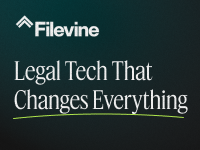 This past week has been a banner week for legal technology ethics guidance. First, there was the release of the American Bar Association’s Formal Opinion 477, which was handed down on May 11, 2017. In this opinion, the Standing Committee on Ethics and Professional Responsibility concluded that because there are more secure electronic communication methods available in 2017, lawyers will need to consider avoiding email for some client communications and use other, more secure electronic methods instead.
This past week has been a banner week for legal technology ethics guidance. First, there was the release of the American Bar Association’s Formal Opinion 477, which was handed down on May 11, 2017. In this opinion, the Standing Committee on Ethics and Professional Responsibility concluded that because there are more secure electronic communication methods available in 2017, lawyers will need to consider avoiding email for some client communications and use other, more secure electronic methods instead.
As set forth in the opinion, factors lawyers must consider when determining the best, most secure method for communicating with clients on a case-by-case basis include:
- the sensitivity of the information;
- the likelihood of disclosure if additional safeguards are not employed;
- the cost of employing additional safeguards;
- the difficulty of implementing the safeguards; and
- the extent to which the safeguards adversely affect the lawyer’s ability to represent clients (e.g., by making a device or important piece of software excessively difficult to use).

How Filevine Bakes AI Into Every Layer Of Your Case Management
It’s like having a junior associate who’s never off the clock.
The Committee explained that “(a) fact-based analysis means that particularly strong protective measures, like encryption, are warranted in some circumstances.” The Committee also cautioned that while using unencrypted email may be appropriate for routine or low sensitivity communications, due to “cyber-threats and (the fact that) the proliferation of electronic communications devices have changed the landscape…it is not always reasonable to rely on the use of unencrypted email.”
This opinion was a long time coming. For years now, I’ve predicted that lawyers in most jurisdictions will be required to communicate and collaborate with clients using encrypted communications and that the platform of choice would ultimately be encrypted communications via client portals built into law practice management platforms.
Over time, all signs pointed toward my prediction becoming a reality. First, the ABA issued Formal Opinion 11-459 in 2011 which suggested this standard might be applicable in the future. Then, in 2015, Texas followed suit with Texas Ethics Opinion 648, as did Washington in Opinion 2016-01 in 2016. But this is the first time an ethics committee has so clearly stated that changing times warrant a new standard regarding secure client communication. In due course, I expect that many other states will soon do the same.
Also of note was the release of the updated Social Media Ethics Guidelines by the Commercial and Federal Litigation Section of the New York State Bar Association. This is the third version of the Guidelines and the first update to be released since 2015. Some of the more notable revisions include:

Inside The Minds Working At US Midsize Law Firms: 2025 Priorities Revealed
Midsize firms want smarter tech, not more. Our 2025 industry report shows how the right tools—and strategy—can drive growth, efficiency, and better client outcomes.
- Attorney Competence (§ 1.A) reflects that 27 states have adopted some duty of technical competence.
- Maintaining Client Confidences (§ 5.E) offers information on how an attorney can respond to online reviews as well as services that offer to import contacts.
- Positional Conflicts (§2.E) is new and discusses DC Bar Ethics Opinion 370 regarding whether social media posts adverse to a client’s interest may present a conflict of interest.
- The revised appendix describes social media terminology and some of the more popular social media platforms.
I’ve always been of the mindset that online communications are simply an extension of offline communications and thus social media interactions should not be treated differently than any other type of communication. As I’ve oft repeated, the medium doesn’t change the message.
For that reason, this 47-page set of guidelines focused solely on the ethics of lawyers using social media gives me pause, as it did when it was first issued, since it would seem to imply that social media communications warrant special and more careful consideration than any other type of communication.
Even so, the Guidelines serve a purpose and provide a very useful, extensive round up of how ethics committees across the country have approached the ethics of lawyers using social media. The Guidelines are a great resource and I would suggest you use them as a handy reference guide for your professional online social media activities.
And if you’re interested in learning more about the updates and happen to reside near New York City, I’ll be speaking on a panel for the New York State Bar Association on that very topic. I hope to see you there!
 Nicole Black is a Rochester, New York attorney and the Legal Technology Evangelist at MyCase, web-based law practice management software. She’s been blogging since 2005, has written a weekly column for the Daily Record since 2007, is the author of Cloud Computing for Lawyers, co-authors Social Media for Lawyers: the Next Frontier, and co-authors Criminal Law in New York. She’s easily distracted by the potential of bright and shiny tech gadgets, along with good food and wine. You can follow her on Twitter @nikiblack and she can be reached at [email protected].
Nicole Black is a Rochester, New York attorney and the Legal Technology Evangelist at MyCase, web-based law practice management software. She’s been blogging since 2005, has written a weekly column for the Daily Record since 2007, is the author of Cloud Computing for Lawyers, co-authors Social Media for Lawyers: the Next Frontier, and co-authors Criminal Law in New York. She’s easily distracted by the potential of bright and shiny tech gadgets, along with good food and wine. You can follow her on Twitter @nikiblack and she can be reached at [email protected].